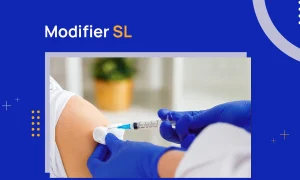Using modifier 26 to report the professional part of an electrocardiography (ECG)? You should stop because there is a code for that! Every medical professional knows how useful ECGs are for observing the heart’s electrical activity. In fact, over 100 million ECGs are performed annually in the U.S.
Among them, the 12-lead electrocardiography is the standard for diagnosing heart diseases. So, how do you bill for this procedure, especially if you only interpreted the results? Instead of using a global code, you can use CPT code 93010. Keep reading to understand the correct application of this code.
What is CPT Code 93010?
You might have already guessed from the intro that CPT code 93010 covers the professional component of an ECG. But what does it actually mean? In simple terms, it helps report a healthcare provider’s role in interpreting the results and documenting them.
To be more specific, healthcare providers use CPT code 93010 to specify that they have only analyzed and reported the results of a 12-lead (or more) electrocardiography. This is known as the professional component of the test.
Appropriate Use Cases for CPT Code 93010
Now that you have a basic understanding of CPT code 93010, let’s move on to understand its correct application through the following examples.
Interpreting ECG Results in an ER
Approximately 17.1% of ECGs are performed in a hospital’s emergency departments. Therefore, suppose an older man, around 65 years of age, arrives at an emergency room (ER) after experiencing chest pain and shortness of breath.
Looking at the severity of his condition, the ER technician immediately performs a 12-lead electrocardiogram to observe his heart’s electrical activity. The on-call physician then takes over, interpreting the results to diagnose the problem. The healthcare provider uses CPT code 93010 to file a claim for his service.
ECG Analysis of a Patient with a Pre-Existing Condition
Healthcare providers perform ECGs more frequently on patients with pre-existing heart issues, such as atrial fibrillation (AFib). Therefore, consider a middle-aged woman (46 years old) who is diagnosed with AFib. She arrives at a hospital’s outpatient department for her bi-yearly ECG test.
The technician monitors the electrical activity of the patient’s heart by attaching 12 electrodes to her chest, arms, and legs. Since the cardiologist is not present during the test, the technician sends the collected data via email. The physician then interprets the results and uses CPT code 93010 to request reimbursement for his service.
ECG Interpretation for a Patient’s Annual Health Evaluation
Did you know that more than 20% of patients undergo an ECG as part of their annual health examination? Therefore, let’s assume a low-risk patient who visits the clinic for his yearly health checkup. Since an ECG is part of his comprehensive tests, the clinic technician performs a standard 12-lead electrocardiogram.
Due to the absence of a qualified physician, he uploads the results in the clinic’s electronic system for interpretation at a later date. The next day, the physician arrives at the clinic, retrieves the ECG results, and interprets them. He then uses CPT code 93010 to report his role in the test.
Modifiers to Append with CPT Code 93010
For conveying additional details about your role, you can use the following modifiers with CPT code 93010.
Modifier 59
Besides interpretation, did you perform another service on the same patient on the same day? Use modifier 59 with CPT code 93010 to request separate reimbursement for your ECG analysis. However, pay close attention to NCCI edits and avoid using this modifier just to overcome them.
Modifier 76
Did the same patient undergo another ECG on the same service date due to clinical issues? Did that compel you to interpret the results of both the ECGs to track the patient’s heart function at different times? Then, append modifier 76 to CPT code 93010 to indicate that the same service was repeated on the same day for medical necessity and avoid duplicate claim denials.
Modifier 77
Did another physician reinterpret the ECG test results and report them to you this time? Then, append modifier 77 to CPT code 93010 to explain to the insurance payer that the professional component of the ECG was repeated on the same day but by another physician.
Reimbursement Guidelines for CPT Code 93010
Here are the key billing requirements for CPT 93010:
Verify that a Physician Only Performed the Interpretation & Reporting
As you might have gathered, CPT code 93010 only covers the analysis and documentation of a 12-lead electrocardiogram. Therefore, use this code if a healthcare provider only interpreted and reported the results, and the technician performed the test. Otherwise, use CPT code 93000 for the technical and professional component of an ECG.
Do Not Use Modifier 26 with Code 93010
Remember that this code already represents the professional component of an ECG. Therefore, avoid using modifier 26 with CPT code 93010 to steer clear of unnecessary denials and rework.
Document the ECG Interpretation Details
Don’t forget one important thing: Documentation! Record relevant information in the patient’s record to avoid reimbursement issues. These include:
- A detailed report, including ECG waveform analysis and relevant findings
- Date and time of the service
- Signature of the interpreting physician
Maintain Compliance
Want to know the actual secret for timely payments? It lies in complying with payer-specific requirements! Always verify coverage, billing rules, and documentation requirements before using CPT code 93010 on claims.
Final Thoughts on CPT Code 93010
So, as you can see, CPT code 93010 is quite simple! It has a straightforward description and application. Since it covers the professional part of a 12-lead electrocardiogram, or interpretation and reporting of ECG results in simple words, you don’t have to use modifier 26 with this code. Healthcare providers frequently use 93010 to request payment for their involvement in an ECG. If you also only interpret the results of an electrocardiogram, use this code to report your role. Ace your coding with our comprehensive guide. But if you need help, entrust your coding to a company offering reliable cardiology billing services.



